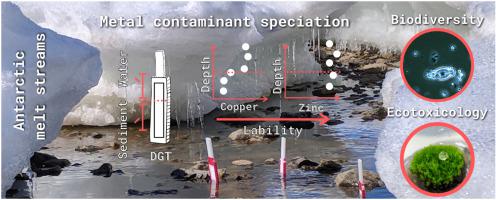当前位置:
X-MOL 学术
›
Environ. Pollut.
›
论文详情
Our official English website, www.x-mol.net, welcomes your
feedback! (Note: you will need to create a separate account there.)
Metal lability and environmental risk in anthropogenically disturbed Antarctic melt streams
Environmental Pollution ( IF 7.6 ) Pub Date : 2021-06-19 , DOI: 10.1016/j.envpol.2021.117627 Darren J Koppel 1 , Jordan Bishop 2 , Kateřina Kopalová 2 , Gwilym A V Price 3 , Kathryn E Brown 4 , Merrin S Adams 5 , Catherine K King 4 , Dianne F Jolley 5
Environmental Pollution ( IF 7.6 ) Pub Date : 2021-06-19 , DOI: 10.1016/j.envpol.2021.117627 Darren J Koppel 1 , Jordan Bishop 2 , Kateřina Kopalová 2 , Gwilym A V Price 3 , Kathryn E Brown 4 , Merrin S Adams 5 , Catherine K King 4 , Dianne F Jolley 5
Affiliation

|
Antarctic melt streams are important ecosystems that increasingly face contaminant pressures from anthropogenic sources. Metal contaminants are often reported in the limno-terrestrial environment but their speciation is not well characterised, making environmental risk assessments difficult. This paper characterises labile metal concentrations in five melt streams and three shallow lakes around the Casey and Wilkes research stations in East Antarctica using chemical extracts and field deployments of diffusive gradients in thin-film (DGT) samplers. An acute toxicity test with field-collected and taxonomic identification of diatoms in melt streams were used to infer environmental risk. Copper and zinc were the most labile metals in the melt streams. DGT-labile copper concentrations were up to 3 μg Cu L in melt-stream waters but not labile below the sediment-water interface. DGT-labile zinc concentrations were consistent above and below the sediment-water interface at concentrations up to 14 μg Zn L in four streams, but one stream showed evidence of zinc mineralisation in the sediment with a flux to overlying and pore waters attributed to the reductive dissolution of iron and manganese oxides. Other metals, such as chromium, nickel, and lead were acid-extractable from the sediments, but not labile in pore waters or overlying waters. All streams had unique compositions of freshwater diatoms, but one had particularly reduced diversity and richness, which correlated to metal contamination and sediment physico-chemical properties such as a finer particle size. In laboratory bioassays with field-collected samples of the Antarctic moss , there was no change in photosynthetic efficiency following 28-d exposure to 700, 900, 1060, or 530 μg L of cadmium, copper, nickel, and zinc, respectively. This study shows that microorganisms such as diatoms may be at greater risk from contaminants than mosses, and highlights the importance of geochemical factors controlling metal lability.
中文翻译:

人为干扰的南极熔流中的金属不稳定性和环境风险
南极融化流是重要的生态系统,日益面临来自人为来源的污染压力。金属污染物经常出现在陆地环境中,但其形态特征尚未得到很好的描述,这使得环境风险评估变得困难。本文利用化学提取物和薄膜 (DGT) 采样器中扩散梯度的现场部署,描述了东南极洲凯西和威尔克斯研究站周围的五个熔体流和三个浅湖中的不稳定金属浓度。通过对熔体流中硅藻的现场采集和分类鉴定进行急性毒性测试,用于推断环境风险。铜和锌是熔体流中最不稳定的金属。在熔体流水中,DGT 不稳定铜浓度高达 3 μg Cu L,但在沉积物-水界面以下则不稳定。在四条溪流中,沉积物-水界面上方和下方的 DGT 不稳定锌浓度一致,浓度高达 14 μg Zn L,但其中一条溪流显示出沉积物中锌矿化的证据,并由于还原作用而流向上覆水和孔隙水。铁和锰的氧化物的溶解。其他金属,如铬、镍和铅,可以从沉积物中用酸萃取,但在孔隙水或上覆水中不稳定。所有溪流都具有独特的淡水硅藻成分,但其中一条溪流的多样性和丰富度特别降低,这与金属污染和沉积物物理化学性质(例如更细的颗粒尺寸)相关。在对现场采集的南极苔藓样品进行的实验室生物测定中,分别暴露于 700、900、1060 或 530 μg/L 的镉、铜、镍和锌 28 天后,光合效率没有变化。这项研究表明,硅藻等微生物可能比苔藓面临更大的污染物风险,并强调了控制金属不稳定性的地球化学因素的重要性。
更新日期:2021-06-19
中文翻译:

人为干扰的南极熔流中的金属不稳定性和环境风险
南极融化流是重要的生态系统,日益面临来自人为来源的污染压力。金属污染物经常出现在陆地环境中,但其形态特征尚未得到很好的描述,这使得环境风险评估变得困难。本文利用化学提取物和薄膜 (DGT) 采样器中扩散梯度的现场部署,描述了东南极洲凯西和威尔克斯研究站周围的五个熔体流和三个浅湖中的不稳定金属浓度。通过对熔体流中硅藻的现场采集和分类鉴定进行急性毒性测试,用于推断环境风险。铜和锌是熔体流中最不稳定的金属。在熔体流水中,DGT 不稳定铜浓度高达 3 μg Cu L,但在沉积物-水界面以下则不稳定。在四条溪流中,沉积物-水界面上方和下方的 DGT 不稳定锌浓度一致,浓度高达 14 μg Zn L,但其中一条溪流显示出沉积物中锌矿化的证据,并由于还原作用而流向上覆水和孔隙水。铁和锰的氧化物的溶解。其他金属,如铬、镍和铅,可以从沉积物中用酸萃取,但在孔隙水或上覆水中不稳定。所有溪流都具有独特的淡水硅藻成分,但其中一条溪流的多样性和丰富度特别降低,这与金属污染和沉积物物理化学性质(例如更细的颗粒尺寸)相关。在对现场采集的南极苔藓样品进行的实验室生物测定中,分别暴露于 700、900、1060 或 530 μg/L 的镉、铜、镍和锌 28 天后,光合效率没有变化。这项研究表明,硅藻等微生物可能比苔藓面临更大的污染物风险,并强调了控制金属不稳定性的地球化学因素的重要性。











































 京公网安备 11010802027423号
京公网安备 11010802027423号